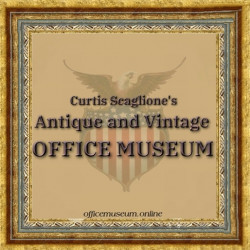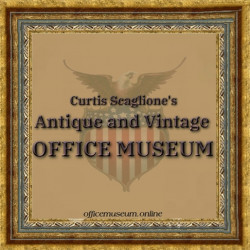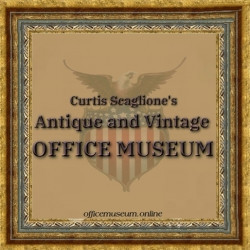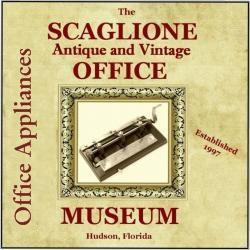Curtis Scaglione's collections
Antique and Vintage Stapler Collection
<p><strong>The Scaglione Antique and Vintage Office Museum</strong></p>
<p><strong><strong>Each image on this page was carefully crafted by Curtis Scaglione for the Smithsonian Institute Learning Lab display. Each machine is a part of the Antique and Vintage Office Museum and the sole property of Curtis Scaglione, the creator of this display.</strong><br></strong></p>
<p>This collection features staplers manufactured between the years 1889 and 1955. It is one of the the most complete collections of antique and vintage paper fasteners in the world. It is interesting to note that some of the machines in this collection have not been seen in years. </p>
<p>Paper Fasteners have been around since the early 1850’s therefore, we have a great selection of antique and vintage machines for review and examination. The development of staplers really took off in the early 1900’s and improvements followed. Many machines produced today are based on designs dating the early 1930's.</p>
<p>Today, we refer to this office machine as staplers. But early paper fasteners included the eyelet machines and pin fasteners.</p>
<p>Even now, some examples are proving to be more desirable to collectors and are harder to find. </p>
<p>When examining the early machines, it is easy to see these machines are historic. They were developed and manufactured during the mechanical revolution, Simple in design yet dependable. These 19th century and early 20th century designs are what you would expect of the era and this is where the concept of paper fasteners began. </p>
<p><br></p>
<p></p>
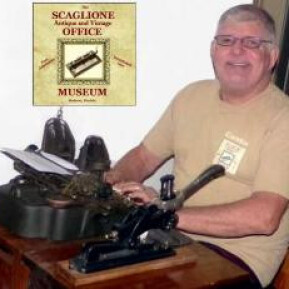 Curtis Scaglione
Curtis Scaglione
107
Antique and Vintage Hole Punches
<p><strong>The Scaglione Antique and Vintage Office Museum</strong></p>
<p><strong>Each image on this page was carefully crafted by Curtis Scaglione, <strong>the creator of this display</strong> for the Smithsonian Institute Learning Lab display. Every machine is a part of the Antique and Vintage Office Museum and the sole property of Curtis Scaglione.<br></strong></p>
<p>This collection features American made hole punches manufactured between the years 1874 and 1945. It is one of the the most complete collections of antique and vintage paper perforators in the world. It is interesting to note that some of the machines in this collection have not been seen in over 100 years. With the exception of wood block cuttings use in the advertisement process, these machines may be the last of their kind.</p>
<p>Hole punches have been around since the early 1870’s therefore, we have a great selection of antique and vintage machines for review and examination. The development of punches really took off in the early 1900’s and improvements followed. Many machines produced today are based on designs dating to 1912.
</p>
<p>Today, we refer to this office machine as a hole punch. During the period dating from 1874 to the 1930's these machines were known as a paper punch, hole punchers, perforators, or paper perforators. There was no standard name for a machine that punched holes in paper.</p>
<p>In 1882 James Shannon filed for a patent for his paper file. While the patent is for a complete paper file, his patent described the paper punch that was part of his invention. After reviewing the patent one is left wondering if he was at a loss as to what to call his hole punch. As a result his invention is overlooked by many and the credit for the invention of the hole punch has been credited to someone else. (enclosed as a pdf at the bottom of this page - The first paper hole punch)</p>
<p>Even now, some examples are proving to be more desirable to collectors and are harder to find. The Globe No. 4 produced by Globe-Wernicke is one such machine that has a following of not only the hole punch collector, but by collectors of the machine age. This machine appears to draw the most interest from individuals wanting an old paper hole punch for the desk or collection. Another example is the early examples of the Tengwell which had a nicely scrolled plate and was mounted on a beautiful oak base.</p>
<p>Variants hold their own interest to many collectors. You will find the same machine, such as the Improved Hummer, was produced by different companies. Research has shown that many companies or their assets changed hands more than once during the century and that the machines were never improved upon or only minor changes were introduced, usually just parts on the machine or the manufacturers name.</p>
<p>When examining the early machines, it is easy to see these machines are historic. They were developed and manufactured during the mechanical revolution, Simple in design yet dependable. These 19th century designs are what you would expect of the era and this is where the concept of paper punches began.</p>
<p> Some were sold by jobbers and traveling men or as we call them, traveling salesmen, while others like the Tatum line and Globe-Wernicke machines were marketed in the trade magazines of the period.</p>
<p>Many paper hole punches have been lost to time, because of modernization, workmanship or better material. Examples such as the Boykin-Roper Speciality Company Hole Punch, or the Sam’l C. Tatum’s Samson, Eclipse, and the No. 27 are just a few of those machines that were lost or discontinued. These machines were the work of Walter Mendenhall, long time employee of the Tatum Company. Compared to the punches today, these machines are complex and curious. Their mechanisms were unique in design and never copied by any other manufacturer. </p>
 Curtis Scaglione
Curtis Scaglione
97
Antique and Vintage Eyelet Machines
<p>The Eyelet Machine or Eyelet Press, as we know it today, dates to 1854 when a man named Hymen Lipman changed the way the early office did its business.</p>
<p>Predating the stapler, the eyelet machine was a common office appliance 25 years before the staple press was marketed.</p>
<p>This office appliance was a common fixture in law offices, courts and used by notaries.</p>
<p>Today, many eyelet machines are mistaken for appliances designed for use by cobblers, in the textile trade, but most patents indicate the primary purpose was for use in an office setting.</p>
 Curtis Scaglione
Curtis Scaglione
13

